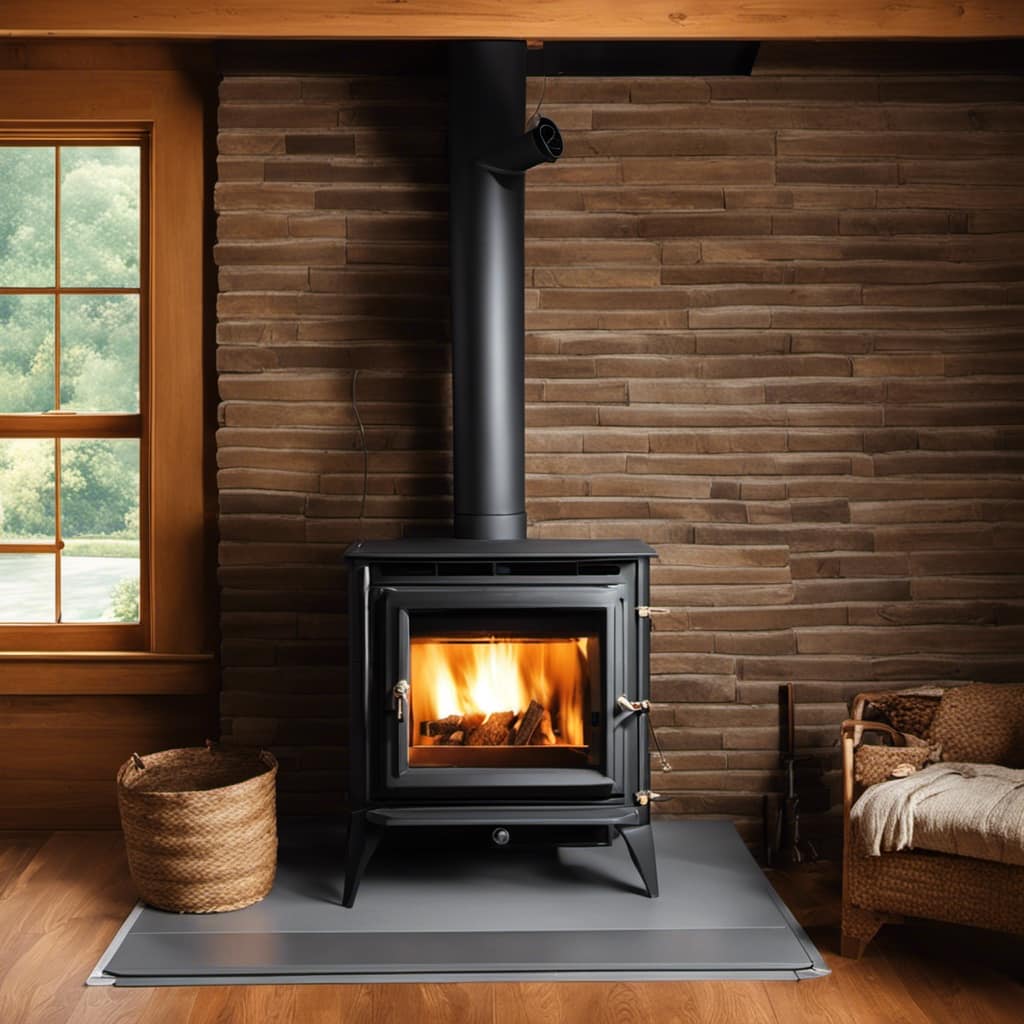To create a cozy reading nook around your wood stove, start by choosing a perfect location, like a corner with natural light. Position an upholstered armchair about three feet away for warmth and comfort. Add plush throw blankets, soft pillows, and a rug to enhance the ambiance. Use built-in shelves or decorative boxes to store a mix of your favorite books. Incorporate warm lighting, like dimmable lamps or fairy lights, to create a soothing atmosphere. Personalize the space with decor that reflects your style and guarantee safety by keeping flammable items at a safe distance. There's so much more to discover!
Key Takeaways
- Position your reading nook near a wood stove while ensuring a three-foot safety clearance for warmth and comfort.
- Select comfortable seating options like upholstered armchairs, floor cushions, and vintage benches to enhance relaxation.
- Organize a diverse book collection with attractive shelving to create an inviting literary atmosphere.
- Use plush fabrics, throw blankets, and layered pillows to add warmth and coziness to the space.
- Incorporate soft, ambient lighting options such as dimmable lamps and fairy lights to enhance the reading experience.
Choosing the Perfect Location
When it comes to choosing the perfect location for your cozy reading nook, consider a spot near the wood stove for that inviting warmth. This not only enhances your comfort but also creates a welcoming atmosphere.
Look for a corner or alcove that allows for a comfortable armchair, ensuring you'll have easy access to the heat without overcrowding the space. To enhance the aesthetic, think about integrating modern farmhouse decor trends with neutral color palettes and natural materials, making the nook feel even more inviting.
It's essential to assess the room layout, keeping a clear path for foot traffic while maintaining safety. Position your reading nook at least three feet away from the wood stove to prevent any fire hazards.
Natural light can greatly enhance your reading experience, so aim for a location near a window. This combination of warmth and light will make your reading nook the perfect spot to curl up with a good book.
Additionally, consider how your reading nook integrates with the existing furniture to promote relaxation and conversation.
With these reading nook ideas, you're well on your way to creating a charming space that invites you to unwind and indulge in your favorite stories.
Selecting Books and Shelves

When selecting books and shelves for your cozy nook, think about how to create a diverse collection that truly reflects your tastes.
Consider incorporating elements that echo the design principles of Mid-Century Modern Design to enhance the aesthetic appeal of your space.
Choose functional storage solutions that not only hold your books but also add to the decor, like open shelving or stylish crates.
Optimal Book Storage Solutions
There's something special about a well-organized book nook, and choosing the right storage solutions can make all the difference.
To create the perfect reading nook, consider installing built-in shelves or wall-mounted units. These maximize vertical space for book storage, keeping everything accessible and tidy.
Organizing your books can be as enjoyable as selecting the right soil for your plants, as it allows for creativity in arrangement.
You can also repurpose crates or decorative boxes for storing books, which adds a rustic charm to your nook. Organizing books by genre or color on open shelves not only creates a visually appealing display but also makes it easy to find your favorite reads.
Don't forget about multi-functional furniture! Ottomans or benches with hidden compartments can store books while providing additional seating, making your nook both cozy and practical.
Curating a Diverse Collection
To create a truly inviting reading nook, you'll want to curate a collection that spans multiple genres and formats. This guarantees you'll have diverse reading experiences, catering to different moods and interests.
As a book lover, think about including:
- Fiction: Immerse yourself in novels that transport you to different worlds.
- Non-Fiction: Explore informative texts that expand your knowledge on various subjects, including cat health and nutrition.
- Poetry: Enjoy the beauty of language and emotion in a compact form.
- Graphic Novels: Experience stories through vivid illustrations and engaging narratives.
Arrange your bookshelves in a way that enhances the cozy atmosphere of your reading nook. You can organize by color, size, or theme, creating visual appeal.
Incorporate personal touches by displaying your favorite books on the top shelf and mixing in decorative items like plants or candles.
Utilize vertical space effectively with wall-mounted shelves or tall bookcases, which can hold more books without overwhelming the area.
Consider repurposing crates or vintage suitcases for unique storage solutions, adding character and charm to your cozy retreat.
Creative Shelf Arrangements
An inviting reading nook thrives on creative shelf arrangements that reflect your personality and interests. Opt for open bookshelves to showcase your favorite reads while making it easy to grab a book and cozy up by the wood stove. Mixing genres and sizes when selecting your books can add character; place tall volumes vertically and stack smaller, decorative ones horizontally for added interest.
Consider incorporating stylish wall clocks to enhance the decor while keeping track of time during your reading sessions transform spaces with stylish wall clocks.
To maximize vertical space, consider wall-mounted shelves near the wood stove, ensuring they're at a safe distance to prevent heat damage. This arrangement not only keeps your books accessible but also adds warmth to the nook. For a visually striking effect, try arranging your books by color or theme, making it simple to find the title that fits your mood.
You can also incorporate crates or repurposed furniture as unique shelving solutions. These can serve dual purposes, providing extra storage for blankets and reading accessories while keeping your cozy reading nook tidy and functional.
With thoughtful shelf arrangements, you'll create an inviting atmosphere that encourages you to relax and plunge into your next adventure.
Comfortable Seating Options

When creating your cozy reading nook, think about incorporating upholstered armchairs for ultimate comfort.
Consider selecting pieces that complement your home's decor style, as there are variety of styles available to enhance home decor that can fit seamlessly with your space.
You might also consider adding floor cushions or poufs for a flexible and relaxed vibe.
Don't forget vintage-style benches or stools, which can add character while providing extra seating options.
Upholstered Armchairs for Comfort
Finding the right upholstered armchair can transform your reading nook into a haven of comfort. These chairs are designed with soft padding and supportive frames, making them perfect for those long reading sessions.
To guarantee you choose the best one, consider the following:
- High-Density Foam Cushions: Look for armchairs that feature high-density foam, as they provide durability and maintain comfort over time. Additionally, choosing a chair that aligns with your cleaning routine can help keep your space tidy, especially if you consider the essential items for a home cleaning kit to maintain your nook's cleanliness.
- Removable Covers: Opt for chairs with removable and washable covers. This makes it easy to keep your reading nook clean and inviting.
- High Back and Armrests: Choose chairs with a high back and armrests for added relaxation and proper posture support during extended reading.
- Warm Colors and Patterns: Select upholstered armchairs in warm, inviting colors or patterns that complement your nook's decor, enhancing the cozy atmosphere.
Incorporating these elements won't only boost your comfort but also create a welcoming space where you can lose yourself in your favorite books.
Floor Cushions and Poufs
Floor cushions and poufs are fantastic additions to any reading nook, offering not only comfort but also versatility in seating arrangements.
These cozy seating options come in various sizes and designs, making it easy to find the perfect match for your decor and color scheme. You'll love how they can be scattered around the space, allowing you and your guests to find just the right spot to settle in with a good book.
For those looking to enhance their outdoor reading experience, consider cushions made from eco-friendly materials that provide both durability and comfort. Filled with memory foam or polyester fiber, floor cushions provide excellent support for those long reading sessions.
Poufs, on the other hand, can serve double duty as footrests or even side tables, enhancing both functionality and comfort in your cozy atmosphere.
Plus, if you choose outdoor-friendly materials, you'll enjoy easy maintenance and durability, especially in high-use areas near your wood stove.
Vintage-Style Benches and Stools
Adding vintage-style benches and stools to your reading nook elevates both comfort and aesthetics. These seating options not only provide a cozy atmosphere but also enhance the rustic charm of your wood stove, making it a perfect spot for enjoying a minimalist lifestyle.
Tiny House Movement Overview emphasizes the importance of creating a comfortable, inviting space in a small home. Here are a few reasons why you should consider incorporating them into your space:
- Comfort: Vintage-style benches often feature plush upholstery or thick cushions that make long reading sessions by the wood stove a delight.
- Durability: Many vintage benches are crafted from solid wood or wrought iron, ensuring they withstand frequent use while offering lasting support.
- Style: Stools with unique patterns or finishes add character to your reading nook, making it a visually appealing spot to unwind.
- Accessibility: You can find a variety of vintage seating options, from tufted benches to mid-century modern stools, at thrift stores, online marketplaces, or antique shops to fit different budgets.
Adding Cozy Fabrics

To create a truly inviting reading nook, you'll want to embrace the warmth and texture that cozy fabrics provide. Start by incorporating plush throw blankets made from fleece or wool. These not only add comfort but also keep you warm while you immerse yourself in your favorite book near the wood stove.
Layering soft, textured pillows in various sizes on your seating can enhance coziness and provide support for those longer reading sessions. Additionally, reflect on how your choice of fabrics can showcase your personal style, much like how certain zodiac signs may enhance overall allure through their unique traits.
When selecting fabrics, aim for heat-resistant and easy-to-clean materials to guarantee safety without sacrificing comfort. A chunky knit or Persian-style rug under your reading nook adds warmth underfoot and absorbs sound, creating a serene atmosphere perfect for diving into a story.
Don't forget to think about curtain panels made of sheer or thermal fabrics. They help regulate temperature, allowing natural light to filter in while maintaining your privacy.
Lighting for Ambiance

Create an inviting atmosphere in your reading nook with carefully selected lighting that enhances both comfort and functionality. The right lighting can transform your space into a cozy retreat that complements the warmth of your wood stove.
Here are some ideas to achieve the perfect ambiance:
- Dimmable LED Lamps: Incorporate these to adjust brightness based on the time of day and your mood, enhancing the cozy vibe around your fireplace.
- Warm-Toned Bulbs: Use strategically placed floor or table lamps that emit a soft, inviting glow, creating a soothing atmosphere.
- Wall Sconces or Pendant Lights: Install these with adjustable brightness near your reading nook for focused task lighting, perfect for diving into your favorite book.
- Fairy Lights or String Lights: Add these around the nook to introduce a whimsical touch and generate a calming ambiance during evening hours.
Don't forget about candles! They provide an alternative lighting source, offering a gentle flicker that enhances the cozy feel—just make sure they're safely placed away from any flammable materials.
With these lighting options, your reading nook will become a warm and inviting escape.
Personalizing Your Space

Your reading nook should reflect your personality and tastes, transforming it into a personal sanctuary. Start by incorporating personal decor elements like family photos, artwork, or handmade crafts that resonate with you. These touches create a warm atmosphere and make the space feel truly yours.
Next, layer in cozy blankets and decorative pillows in colors and patterns that enhance your comfort. This not only adds visual appeal but also invites you to snuggle up with your favorite book.
Consider including a small bookshelf or repurposed crates to display the titles that hold special meaning or inspire you, showcasing your unique literary preferences.
For lighting options, personalize the space with unique lamps or charming string lights. These will provide adequate illumination while also enhancing the overall ambiance.
Safety Considerations Around Stoves

While enjoying the warmth of a wood stove, it's essential to prioritize safety to prevent potential hazards. Here are some important safety considerations to keep in mind:
- Maintain Clearance: Always maintain a minimum clearance of three feet around the wood stove. This helps prevent fire hazards and allows for safe access.
- Use Non-Combustible Materials: Choose non-combustible materials, like tile or stone, for flooring and wall coverings near the stove. These materials provide added protection against heat.
- Install a Heat Shield: If your stove is near walls, consider installing a heat shield. This reduces heat transfer and protects surrounding surfaces from damage.
- Regular Maintenance: Regularly inspect and maintain your wood stove and chimney. Check for creosote buildup, as this can minimize fire risks and guarantee efficient operation.
Additionally, keep all flammable materials—wood, textiles, and decorations—at least three feet away from the stove.
Frequently Asked Questions
How to Make a Comfortable Reading Nook?
To make a comfortable reading nook, choose soft seating, add cozy textiles like blankets, and place a side table for your books. Use warm lighting and personalize the space with decor that reflects your style.
How to Make a Nook Cozy?
To make a nook cozy, you'll want to incorporate soft textiles, choose warm colors, and add ambient lighting. Personalize the space with decor that reflects your style, ensuring it feels inviting and comfortable for relaxation.
How Do You Make a Reading Nook With No Space?
To make a reading nook with no space, identify underutilized areas in your home. Use vertical storage, compact furniture, and soft cushions. Add effective lighting to enhance comfort without crowding your cozy corner.
Where Is the Best Place to Put a Reading Nook?
You'd think the best reading nook would be in a bustling space, right? Actually, it's a quiet corner, preferably near a window, where you can escape distractions and soak in those cozy vibes.
Conclusion
So, as you curl up in your cozy nook, surrounded by books and plush pillows, you might chuckle at the thought of a roaring fire being the least cozy part of your retreat. After all, who wouldn't want to add a little warmth to their reading? Just remember, while you're lost in your novel, keep an eye on that wood stove—it's the only thing hotter than your latest page-turner! Enjoy your snug haven, but stay safe!











